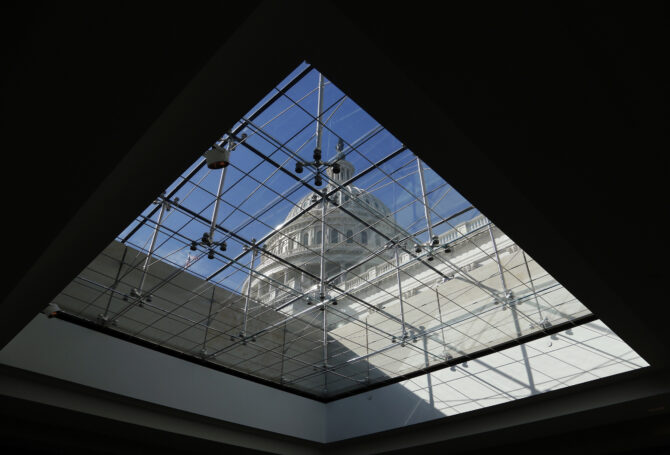
Professor Identifies Debt Rescue in 155-Year-Old Constitutional Provision
Contemporary conversations about the Fourteenth Amendment usually focus on Section 1 and the constitutional right to an abortion. Professor Eric Foner says it would be just as timely to check out what Section 4 of the Fourteenth Amendment says about national debt.
“Section 4 offers a 155-year-old way out of the current impasse over increasing the national debt ceiling,” according to Columbia University history professor, winner of the Pulitzer Prize and author of The Second Founding: How the Civil War and Reconstruction Remade the Constitution.
For those who have never read Section 4, it says, “The validity of the public debt of the United States, authorized by law, including debts incurred for payment of pensions and bounties for services in suppressing insurrection or rebellion, shall not be questioned.”
The section was added to the Fourteenth Amendment to resolve a conflict over repayment of government bonds issued by the Union to finance the Civil War. Mixed up in the debate was whether to reimburse war debts of the Confederate army and the financial losses of slaveholders. The section effectively established the concept of “full faith and credit” of the federal government.

Eric Foner
“Whatever one thinks of Civil War-era fiscal policy, the amendment’s language is mandatory, not permissive – the validity of public debt ‘shall not be questioned,’” Foner writes in an op-ed in The New York Times. “Today, over a century and half after the amendment’s ratification, this promise is no longer considered an ‘extraordinary guarantee’; it is an essential attribute of a modern economy.”
“Our Constitution is not self-enforcing,” Foner explains. “The Fourteenth Amendment concludes by empowering Congress to carry out its provisions. If the current House of Representatives abdicates its responsibility, throwing the nation into default by refusing to raise the debt limit, President Biden should act on his own, taking steps to ensure that the federal government meets its financial obligations, as the Constitution requires.”
The Republican-controlled House has refused to consider a stand-alone debt ceiling increase without significant spending cuts. Biden has refused to negotiate, producing a stalemate as existing federal spending obligations have reached the current budget ceiling, which was set in December 2021.
There are just so many points of leverage, and the debt ceiling is one of them.
Debt Ceiling History
The debt ceiling was created by Congress in 1917 during World War I, allowing the U.S. Treasury to issue Second Liberty Bonds and take on debt without specific congressional approval, as long as the overall debt didn’t exceed a statutory ceiling. The initial debt ceiling was $11.5 billion. In 1939, Congress aggregated all federal debt and raised the debt ceiling to $45 billion.
The national debt has continuously grown and the debt ceiling has been raised under every administration since President Herbert Hoover. The debt ceiling was increased 90 times during the 20th century. During the 1980s, the debt ceiling rose from $1 trillion to $3 trillion. Congress suspended the debt limit rather than raising it seven times since 2013.
The current debt limit is $31.381 trillion. The lame duck session, with Democrats in control of the House and Senate, adjourned late last year without raising or suspending the debt limit despite being aware the ceiling was near. Treasury Secretary Janet Yellen announced the current debt ceiling was reached January 19.

Janet Yellen
Extraordinary Measures
To avoid default, Treasury is executing “extraordinary measures” such as prematurely redeeming Treasury bonds held in federal employee retirement savings accounts, halting contributions to government pension funds, suspending state and local government series securities, and borrowing from money set aside to manage exchange rate fluctuations, according to the nonpartisan Committee for a Responsible Federal Budget. Treasury first employed these measures in 1985 and used them six times during a similar debt ceiling standoff in 2011.
“The Treasury Department’s use of extraordinary measures simply delays when the debt will reach the statutory limit,” the Committee says. “Spending in excess of incoming receipts has already been legally obligated; that spending will push debt beyond the ceiling. There is no plausible set of changes that could generate the instant surplus necessary to avoid having to raise or suspend the debt ceiling indefinitely.” Yellen predicted these measures would only stave off default until June.
The Committee says Treasury could take bolder, “unprecedented actions” such as “selling large amounts of gold, minting a special large-denomination coin or invoking the Fourteenth Amendment to override the statutory debt limit.”
“Whether any of these tools is truly available is in question, and the potential economic and political consequences of each of these options are unknown,” the Committee concludes. “Realistically, once extraordinary measures are exhausted, the only option to avoid defaulting on our nation’s obligations is for Congress to change the law to raise or suspend the debt ceiling.”
Decision Time Line
Sparring over the debt limit will continue for months. The Biden administration says it will aim for a showdown on the debt ceiling after the mid-April tax deadline. Meanwhile, House Republicans have demanded spending cuts, including to Medicare and Social Security, as the price for raising the debt ceiling. Congressman Chip Roy, R-Texas, put the point succinctly: “You only have so many leverage and negotiating points. The debt ceiling is one of those.”
Senate Majority Leader slammed “gratuitous partisan politics” and said lifting the debt ceiling is necessary to borrow the money to meet already budgeted expenditures. “Political brinkmanship with the debt limit would be a massive hit to local economies, American families and would be nothing less than an economic crisis at the hands of the Republicans.”
Federal Spending Perspective
If federal spending was a dollar, here’s how the money would be allocated:
- About 62 cents is spent on entitlement programs – Social Security gets 22 cents, Medicare gets 17 cents and Medicaid gets 10 cents.
- About 14 cents go to national defense.
- Almost 8 cents pays interest to holders of Treasury bonds.
- The remaining 16 cents is spent on the rest of federal government programs.
In this example, the federal government spends 17 cents more than it receives in revenue.




